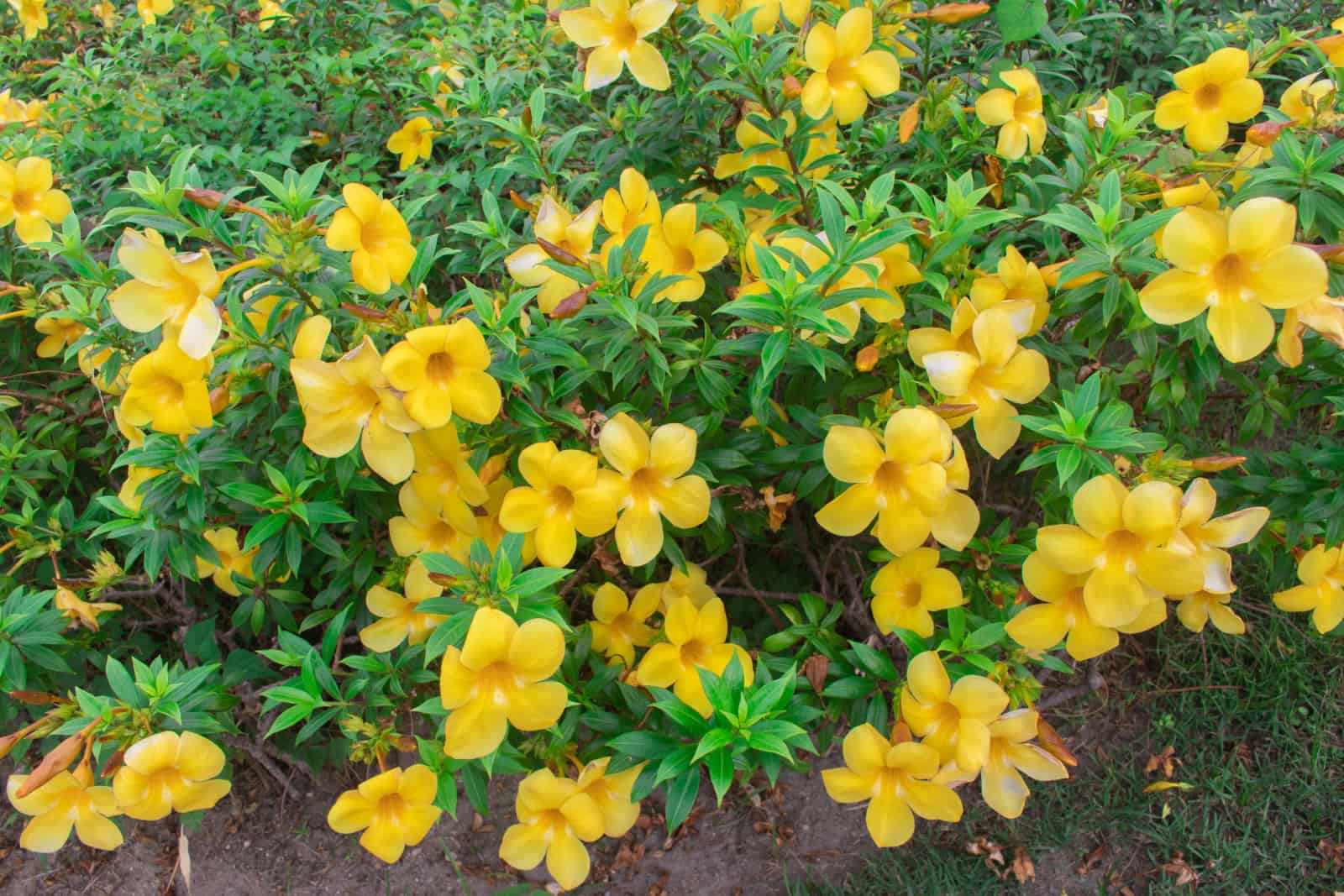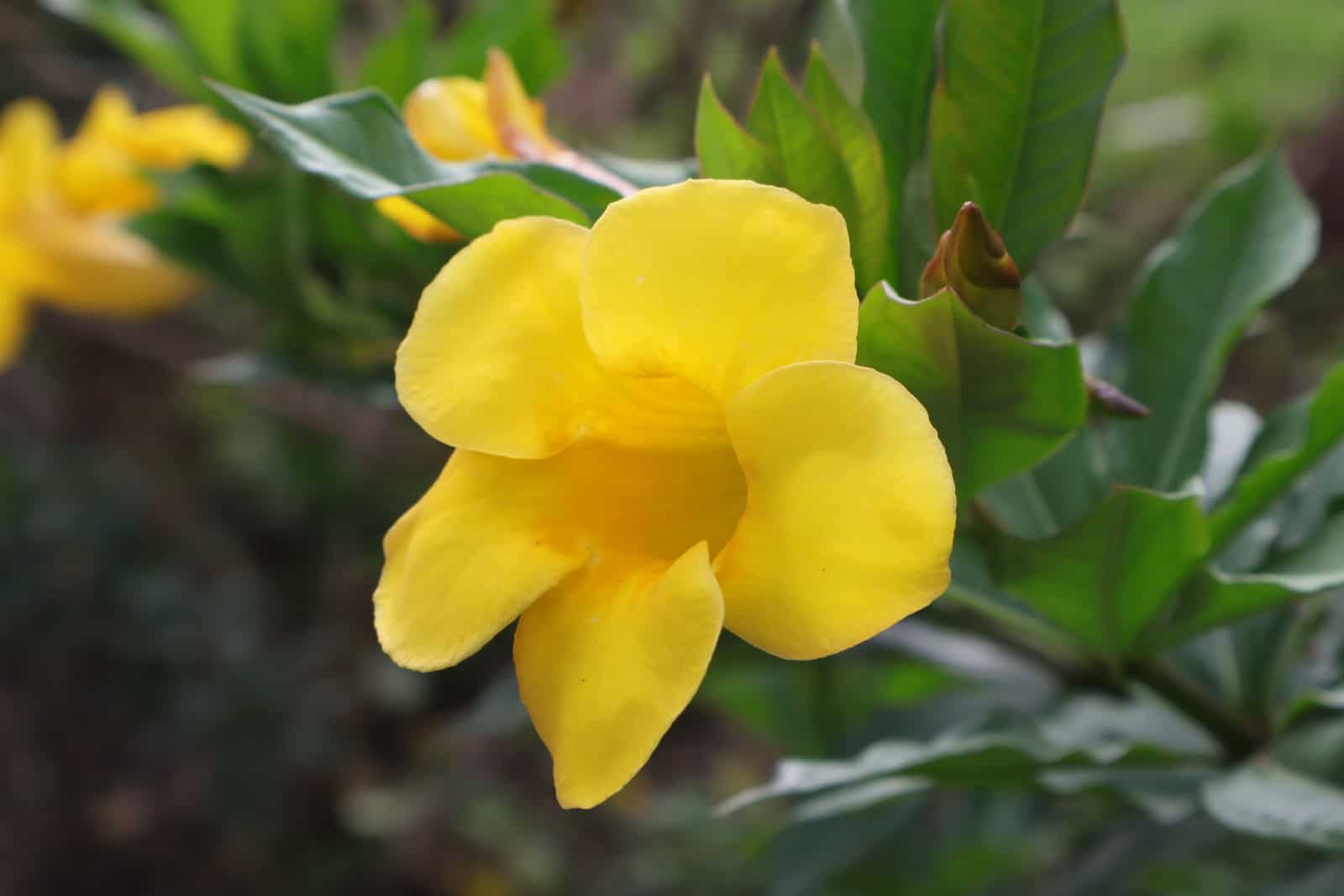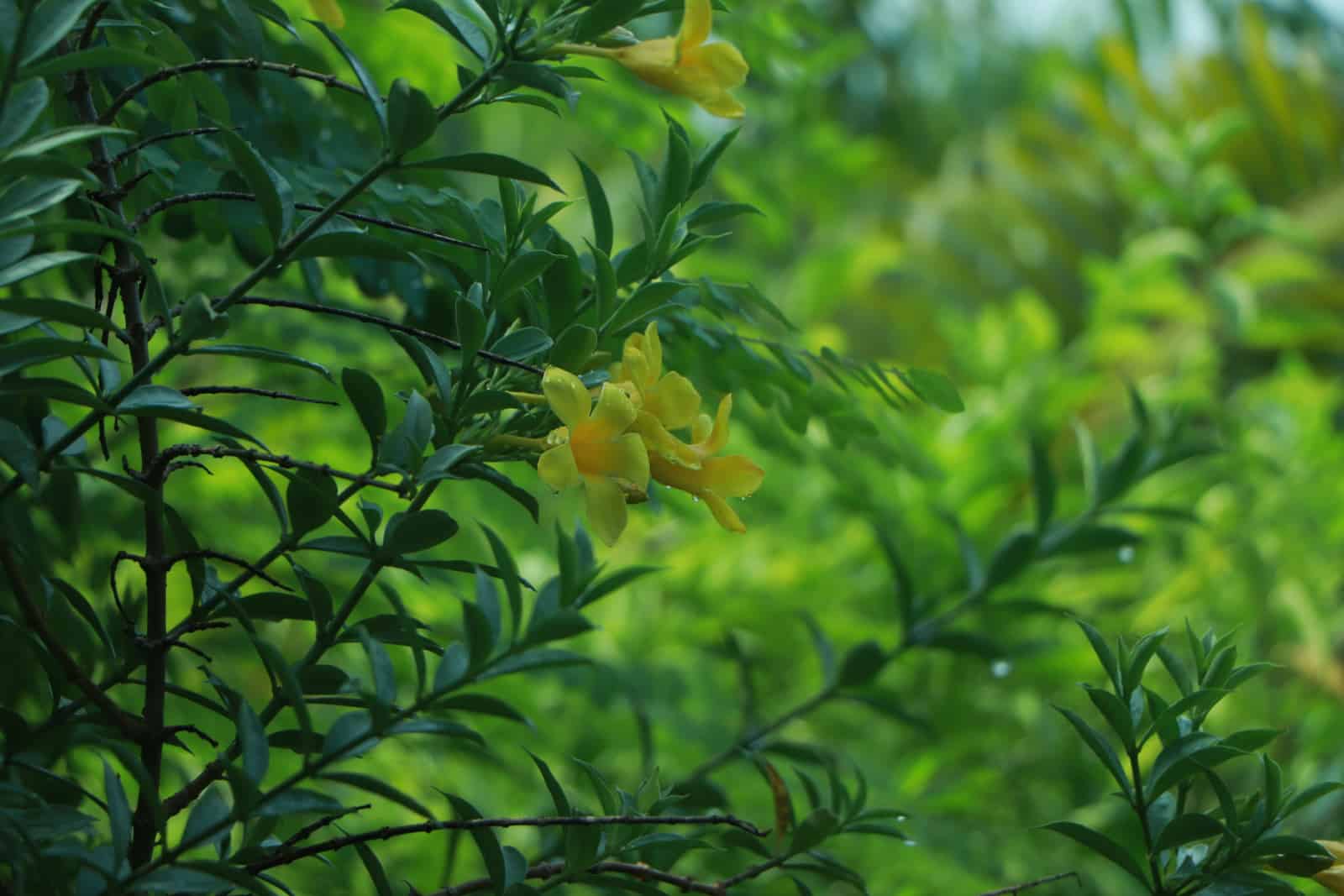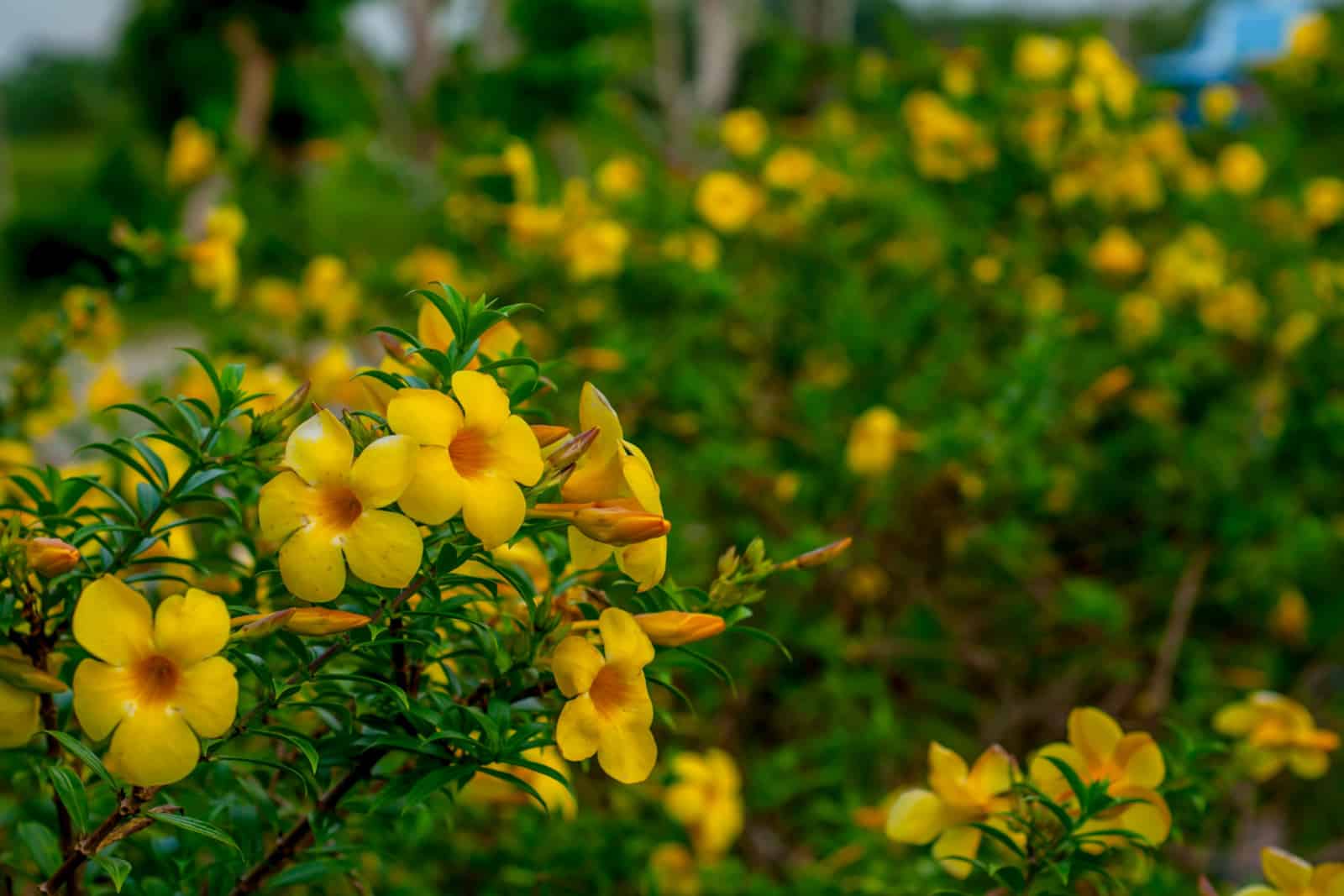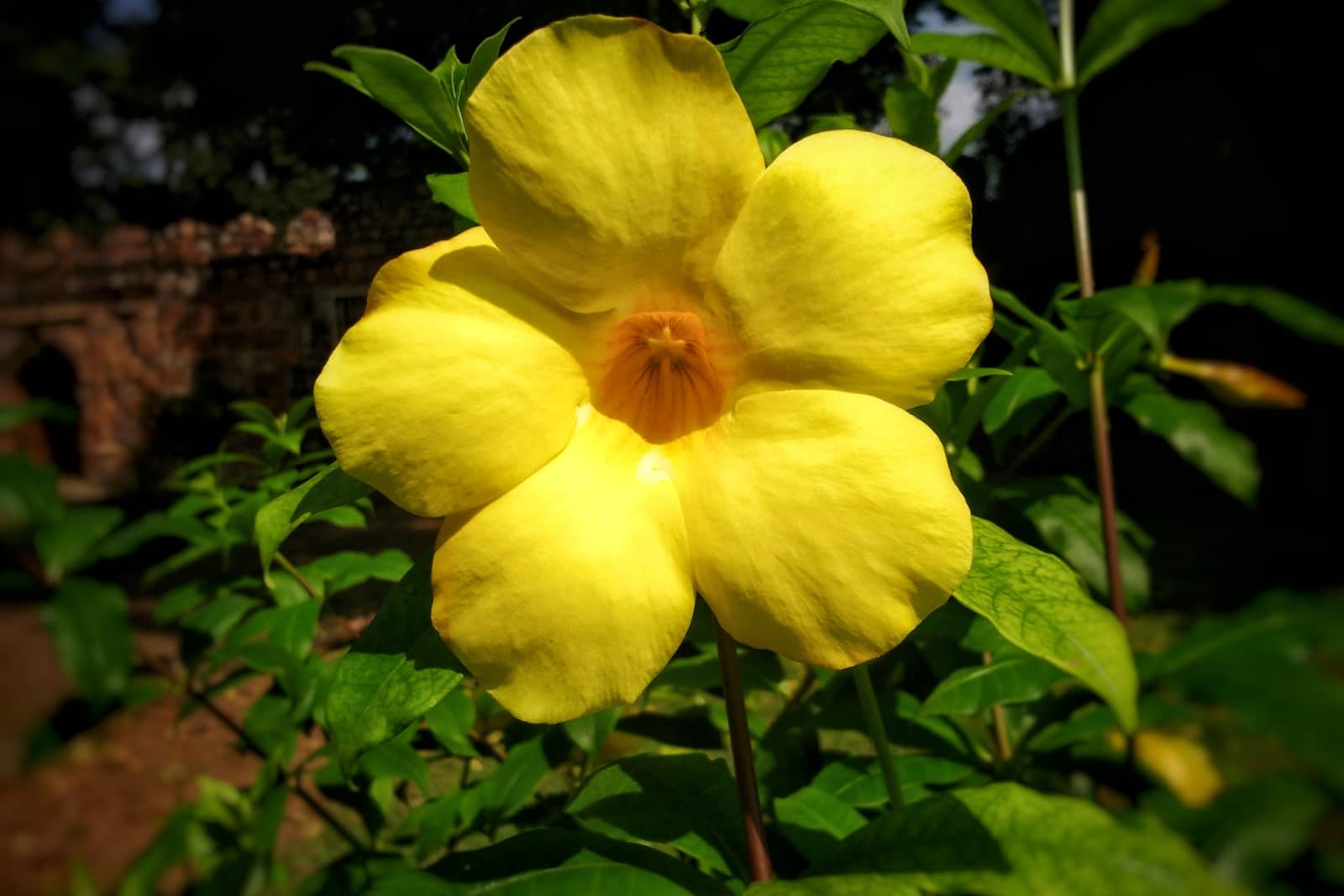If you want to add more color to your landscape, you should definitely check out the allamanda bush! This impressive tropical plant with golden-yellow flowers can perfectly decorate any area.
In addition to a beautiful yellow color, you can also choose other allamanda varieties that produce red or purple flowers.
What’s amazing about this plant is that it is a vine, but we frequently prune it as a bush, which we’ll discuss further in the sections below.
Speaking of pruning, that’s not the only form of care required for this plant; you need to pay attention to the hardiness zone you live in and adjust its location and watering needs accordingly, as well as prepare the best soil mix and fertilizer, etc.
We’ll talk about all these things, but for now, let’s learn more about this flowering shrub:
Scientific name: Allamanda schottii (Allamanda cathartica)
Common names: Golden trumpet, common trumpet vine, yellow allamanda, golden-trumpet vine, yellow bell
[table id=509 /]
Allamanda Bush Care Guide
If you live in the south of Florida or any other place with a similar climate, you’ll be very happy to hear that there is a beautiful shrub that is incredibly easy to grow – the golden trumpet vine!
The bush allamanda requires full sun conditions and warm temperatures, has average water needs, and prefers fertile soils with good drainage.
You should know some other things about this pollinator-friendly plant, such as how and when to propagate, repot, and prune it, and we’ll discuss all of them below.
Let’s begin!
Light Requirements
The Allamanda bush does best in full sun conditions, so it’s a perfect landscape addition in warmer regions.
It can also handle some shade, especially in hot climates when the afternoon sun is really harsh.
And if you don’t have such a place outdoors, you can always grow this tropical shrub in your indoor garden; just make sure it gets bright indirect light.
Another good thing about growing plants indoors is that you can use artificial lights if they turn leggy or stunted.
Remember, this plant will turn a nice dark shade and produce more lovely and fragrant blossoms.
Water And Humidity
The yellow allamanda bush has moderate moisture needs, and you won’t have to irrigate it daily. The best way to water this plant is by checking the top few inches of the growing medium; if it’s dry, you should water your shrub.
You’ll need to irrigate your yellow allamanda approximately once a week, but the amount of water depends on the size of the container.
For instance, an allamanda bush plant grown in a 5-inch planter will require a cup of water per week, but those grown in 10-inch pots will need 2-3 cups.
These plants generally require more moisture during their growing season and on warmer days, so always check the soil before irrigating!
And lastly, tap water isn’t the best option since the golden trumpet vine is sensitive to chlorine. The good news is that rainwater is good for plants, including this one, so you can collect it or leave your plant outside to drink from a natural source!
Humidity
The Allamanda bush is a tropical shrub, which means it needs higher humidity levels to thrive. When grown indoors, you can simply mist it or turn on a humidifier to raise the average air moisture level to 50%.
Outdoor plants require a bit more care. Mulch your plant and mist it every morning with distilled or rainwater to increase humidity.
You can also place buckets of water around it, which will evaporate in the sun. Moisture from the soil also evaporates, increasing the humidity but depleting the growing medium, so don’t forget to water your allamanda vine more frequently.
Temperature Requirements For The Bush Allamanda
This trumpet bush does best when nighttime temperatures stay above 60°F, although it can tolerate temperatures lower than that.
If you live in a region where temperatures drop below 40°F, take your bush allamanda indoors where the cold can’t hurt it.
Also, avoid keeping your yellow bell allamanda in drafty areas, such as near old windows, doors, AC, or heaters, since they can increase temperature fluctuations and lower the humidity.
Soil And Fertilizer
This yellow shrub thrives in fertile, well-draining soils and tolerates neither drought nor wetness. Therefore, you should amend the soil with organic matter, which will retain moisture and increase drainage at the same time.
Another excellent material is coco coir for plants, which you can use to mulch your yellow bush or to mix into the substrate to increase drainage and aeration. If you grow this allamanda in a container, you can also add perlite or vermiculite to improve drainage and aeration.
Finally, this yellow-flower plant prefers mildly acidic to mildly alkaline soil pH between 5.6 and 7.8 to absorb moisture and nutrients properly.
Fertilizer
Allamanda plants grow fast and may need to be fertilized once or twice a month during their growing season. Give them organic fertilizer or work some compost into the soil.
You can also use all-purpose, well-balanced liquid plant food such as triple 10 or triple 8, which you should dilute to half-strength.
Finally, a bush allamanda planted in the ground will benefit from slow-release fertilizers, which you can add to your plants three times during their growing season.
Pruning The Golden Trumpet Plant
The best time for pruning this plant is while it’s still in dormancy, which is some time in late winter or early spring. This will encourage blooming and control its spread.
Only cut old shoots since yellow flowers appear on new growth. Trim leggy and long vines because they can taint the looks of your shrub. Remove fragile and cramped branches to improve airflow and prevent fungal infections.
The good news is that established plants require less pruning, and you’ll soon be able to relax and enjoy the bright yellow trumpet flowers.
Finally, you should deadhead withered blossoms to encourage the growth of new ones.
How And When To Repot The Bush Allamanda
The best time to repot or transplant your golden trumpet vine is in spring when it actively grows and has more than enough time to prepare for winter.
When repotting or transplanting the yellow allamanda, always remove the growing medium around their root ball and plant them to the same level they were kept at before.
Amend the substrate with some compost and water the plant thoroughly after moving it.
If you want to control the growth of your bush allamanda more efficiently, you can trim its roots when repotting it and keep it in the same container.
Finally, if you want to transplant this shrub outside, you need to bear spacing in mind. This bush unwinds at the top, so make sure you plant it around 3-4 feet apart from other allamanda shrubs, houses, or pathways.
Propagation Of The Allamanda Schottii
The good news is that you can propagate the yellow bell allamanda from stem cuttings. The best time to multiply it is in early spring, but you can do it in any season except winter.
Step 1. Take a healthy softwood cutting around 6 inches long.
Step 2. Remove the bottom leaves, put the cutting in a glass jar filled with water, and place the vessel in a sunny spot. Keep the cutting away from direct sunlight as it can burn it.
Step 3. Change the water every couple of days to keep it fresh.
Step 4. The cuttings should develop roots in about four weeks. Once the root system is about 1/2-1 inch long, you can transplant the new plant into the soil.
* You can also propagate the cutting in a seed-starting mix, but in that case, you’ll need to get the best rooting hormone available to speed up the growth. Maintain moist soil until the roots develop, then transplant the cutting into a larger container.
Issues Due To Inadequate Yellow Allamanda Plant Care
The most common allamanda bush problems include pest infestations, disease infections, and sunburnt leaves – but even they are a rarity.
Pests won’t infest your plants if they’re in top-notch condition; the fungi won’t infect it if you don’t overwater or overmist it, and the sun won’t burn it if you monitor it and move it to a more secluded area when it gets too hot!
The usual pests that attack this beauty are aphids and spider mites, and you can get rid of them by introducing their natural enemies into your garden, such as ladybugs.
But if you don’t want any bugs in your yard, you can always use insecticidal soaps, horticultural oils, or pesticides if nothing seems to be working.
Beautiful green leaves can change color to yellow or get some brown spots, and the most common reason for this is harsh sunlight.
However, leaf discoloration is also a symptom of root rot, along with stunted growth, wilting, a funky smell coming from the pot, etc. If you notice these things, check the plant’s root ball, and if the roots are soft and dark, you should prune them.
You should also consider using different products; for instance, copper fungicide and neem oil can both be used to manage and prevent certain fungal diseases, but neem oil can also deter pests.
Landscape Uses For The Yellow Bell Plant
You can use yellow bushes for landscaping, and what better choice than an allamanda shrub that can turn into a vine if you want it to?
You can create flowering hedges in Florida with it or use a single specimen as a centerpiece for your garden.
The yellow allamanda is an ideal corner accent for your landscape or house, and you can combine it with other shrubs, such as dwarf allamanda, purple allamanda, or hibiscus, to great effect.
Plant it along a fence, driveway, patio, or pathway, use it to create shade for other flowering plants, or train it to vine along the walls.
You can turn allamanda shrubs into a privacy screen, use them to decorate entry points to your garden, or introduce more texture around the base of taller trees.
The options are endless, but know that wherever you plant it, it will look amazing!
FAQ
We have discussed the main care guide for the allamanda bush, but we need to mention a few other things!
Is the allamanda bush perennial or annual?
The allamanda bush is an evergreen perennial in USDA zones 10-11.
It can be grown as an annual in regions north of zone 10, but growers around the world tend to take it indoors once the temperatures drop below freezing and overwinter it somewhere warm.
What is the blooming season of the allamanda bush?
The bush allamanda typically displays its fragrant, golden-yellow flowers from July to November (and even December in the far South) when grown in USDA zones 10-11.
The blooming season will end sooner if you grow it in cooler regions.
Final Thoughts
This article included everything you need to know about caring for the allamanda bush. This plant needs lots of sunshine, water about once a week, well-drained soil, mild temperatures, and fertilizer three times a year if grown in the ground or 1-2 times a month if planted in pots.
We also discussed its more advanced requirements, such as pruning, repotting, and propagation, and brought some excellent ideas for incorporating this plant into your landscape.Enjoy your new yellow bush allamanda, and until next time!
Like this post? Share or pin it for later!


